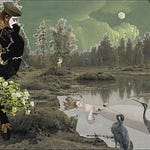XLVIII. SOUPER SUR L’EAU
En d’alanguissantes yoles Au pavillon de bleu turquin, Pierrot, Colombine, Arlequin Font saigner les rouges fioles.
Les femmes ont de lucioles Diamanté leur casaquin, En d’alanguissantes yoles Au pavillon de bleu turquin.
Enrichissant ces fanfioles,
La lune luit comme un sequin,
Et sous un rose baldaquin
Madrigalisent les violes,
En d’alanguissantes yoles.
XLVIII. SUPPER AFLOAT
Aboard enervating yawls flying jacks of dark slate blue, Pierrot, Colombine, Arlequin bleed the red bottles dry. The ladies have set glow-worms a-shine like diamonds on their casaquins, aboard enervating yawls flying jacks of dark slate blue. Turning this tawdry trash to riches, the moon shines like a gold ducat, and under a rose-pink canopy viols play out madrigals, aboard enervating yawls.
NOTES (by line number, starting with the title)
2 yole : « Sorte de petit canot léger qui va à la voile et à l’aviron », ‘A sort of light, small dinghy that can be propelled by sails and by oars’ (DAf1878). Cognate to E. ‘yawl’, which will do for the translation.
alanguissantes : Gerund of alanguir, « Rendre languissant. Il est peu usité », ‘To make languorous. It is little used’ (DAf1878). In turn (also DAf1878), languissant is the gerund of languir: literally, « Être dans un état d’abattement et de faiblesse causé par quelque maladie qui ôte peu à peu les forces », ‘To be in a state of exhaustion and weakness caused by some illness that deprives [one of one’s] strength bit by bit’; and figuratively, « Des ouvrages d’esprit qui manquent de force, de chaleur, de vivacité », ‘Of works whose spirit lacks strength, warmth, vivacity’. (See also the note on phtisique at XXI.2, about “the perverted attitude of the romantic era” toward la maladie de langueur, i.e., tuberculosis.) The current edition of DAf adds, for the first time, « Spécialement. Tomber dans un état de langueur amoureuse ; exprimer cet état », ‘Special case. To fall into a state of amorous languor; to express such a state’.
3 pavillon : See XXV.13.
bleu turquin : See XI.12.
4 Pierrot, Colombine, Arlequin : “Columbine, the ideal; […] Harlequin […] represents love, wit, mobility, audacity, all the showy and vicious qualities; Pierrot […] is the ancient slave, the modern proletarian, the pariah, the passive and disinherited being […].” (Gautier, translated by Maurice Sand; see Appendix B.)
5 font saigner les rouges fioles : Literally, ‘exsanguinate the red bottles’. Presumably the bottles were originally red with wine.
6 lucioles : DAf1878 says luciole can be either le ver luisant (‘the glow-worm’) or la mouche luisante (‘the fire-fly’). DAf1935 says that luciole is a genus of beetles, sometimes confounded with glow-worms. The current edition says luciole is a beetle which as an adult is winged and luminescent; adds that it is often confounded with the glow-worm, the wingless female of the lampyre beetle, which has a luminescent abdomen; and further notes that luciole is an 18th century loan-word from Italian lucciola.
7 casaquins : See IX.4.
9 bleu turquin : See IX.12.
10 fanfioles : According to Littré, a variant of fanfreluche, which DAf1878 defines as a colloquial way to speak disparagingly of a vain, frivolous, cheap ornament.
11 sequin : See XI.7.
12 baldaquin : Originally a rich fabric woven in Baghdad for use in tent-making, then by metonymy such a tent. Medieval Italian rendered (the Arabic for) Bagh-dad as Baldacco, whence the Italian adjective baldachino and French « baldaquin ». See Picoche and (in more detail) Devic.
13 Madrigalisent : No edition of DAf includes the infinitive madrigaliser, but the 1884 supplement to Littré’s Dictionnaire de la Langue Française (Hachette, Paris) does, tagging it as Néologisme and defining it as « faire des madrigaux », ‘to perform madrigals’ (not ‘to compose’ them). Giraud would have learned it earlier, perhaps from the source of Littré’s illustrative quotation, H. Murger’s 1852 novel Scènes de la vie de Bohème (better known as the basis of Puccini’s La Bohème): Giraud, like Murger, was a passionate defender of « art pour l’art », ‘art for art’s sake’ (see Appendix C). The full quotation suggests that Murger and Giraud may have had other passions in common: « Isolé dans un coin avec une jeune femme venue là par hasard et dont il s’était emparé, le poète madrigalisait avec elle de la parole et des mains », ‘Alone in a corner with a young lady who had come there by chance and with whom he was much taken, the poet performed madrigals with her using words and hands’. In view of my suggestion (at VI.3) on the latent content of « La Sérénade de Pierrot », it may be significant that the « violes » are the grammatical subjects/agents, rather than the objects/patients, of « Madrigalisent ».










Share this post